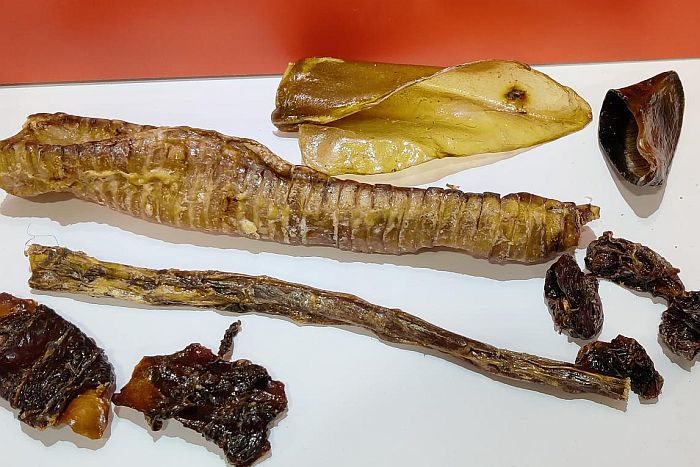- July 15, 2022
- No Comment
- 8 minutes read
4 novel animal by-product pet food ingredients – PetfoodIndustry.com

Pet food ingredients can make use of many parts of an animal that would otherwise be wasted. Every bone, cut and skin scrap used means more efficient use of the feed, water and other resources used to rear the livestock, even when farming silkworms. Some pet food formulations include novel protein sources like water buffalo to avoid allergies, provide variety in diets and meet consumer demands. Like other livestock, kangaroo and other unconventional creatures have parts people don’t want to eat. These novel protein by-products can provide nutritional tools for developing new pet food products that meet consumer demands for sustainability.
Water buffalo
More than 200 million domesticated water buffalo live around the world. Most of them live in Asia, where the animals were domesticated (twice actually, into swamp and river varieties). The animals provide milk, meat, leather and labor. Just as with cattle and other livestock familiar to U.S. farmers, butchering the animals results in co-products that humans can’t or prefer not to eat. Those buffalo by-products, such as horns, lungs and udders, can serve as novel ingredients for dog treats and chews with social benefits and lower environmental impact than other protein sources.
Kangaroo
Kangaroo may seem a novel ingredients to the global pet food industry, but dogs have dined on marsupial meat and co-products for thousands of years. Dingos have eaten kangaroo for a long time, but only recently have other dogs gotten the opportunity.
Wag, a dog treat brand, uses several kangaroo organ meats, along with other kangaroo cuts not in high demand among humans, like the tail bones. Wag uses three organ meats from marsupials: the heart, high in zinc and omega-3 and -6 omega acids, the lungs, with iron, zinc and fatty acids, and the liver, which can be broken apart as a training treat.
Silkworm
In Taiwan, an agricultural research station developed a means to use silkworm in cat food. Researchers at the Miaoli District Agricultural Research and Extension Station developed a means to process silkworm pupae after the cocoons were harvested for silk production. Some cat owners who tried the canned pet food reported cat their cat’s feces produced less odor than when fed their conventional diets and that the cat’s fur became more luxuriant. The director of the research station noted that silkworm pupae contain natural antimicrobial chemicals, along with protein, fats, carbohydrates, chitin and omega-3 fatty acids. The technology developed at the research station was transferred to a biotechnology company for mass production.
Tuna bone
Thai Union Group PCL has a literal bone to pick that will stand to benefit household pets, especially those experiencing calcium deficiency. Its subsidiary, Thai Union Ingredients (TUI), ushered in 2021 by introducing a new product called UniQTMBone made from the bones of tuna. Crushed into an off-white powder, UniQTMBONE promises to deliver a range of nutrients for bone health when used as supplements in capsule and tablet forms, added to different kinds of human food or used as an additive for pet food and pet nutrition. TUI guarantees that UniQTMBONE can be incorporated in products without affecting the sensory characteristics because the fine powdered tuna bones have neither a strong taste nor smell. They also vouch for its efficacy as marine fish bone, they say, is a form of calcium that is readily absorbed by the body.
Tim Wall covers the dog, cat and other pet food industries as senior reporter for WATT Global Media. His work has appeared in Live Science, Discovery News, Scientific American, Honduras Weekly, Global Journalist and other outlets. He holds a journalism master’s degree from the University of Missouri – Columbia and a bachelor’s degree in biology.
Wall served in the Peace Corps in Honduras from 2005 to 2007, where he coordinated with the town government of Moroceli to organize a municipal trash collection system, taught environmental science, translated for medical brigades and facilitated sustainable agriculture, along with other projects.
Contact Wall via https://www.wattglobalmedia.com/contact-us/
In the June 2022 issue of Petfood Industry, read about vegan formulations, mergers and acquisitions, and pet supplements.
READ MORE in Petfood Industry magazine
Feature
By Lindsay Beaton
Those in the supplements space are answering consumer calls for functionality, traceability, and simple education on what’s right for their pets.
READ MORE in Petfood Industry magazine
Feature
By Lindsay Beaton
Healthy M&A activity as well as expanded production capacity investments helped pet food companies continue to grow in 2021.
READ MORE in Petfood Industry magazine

